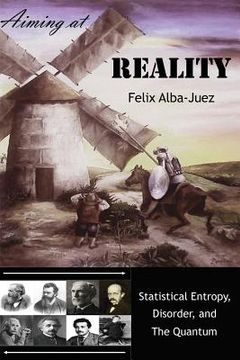Compartir
Aiming at REALITY: Statistical Entropy, Disorder, and the Quantum (en Inglés)
Felix Alba-Juez
(Autor)
·
Riccardo Fortunati
(Prefacio de)
·
Independently Published
· Tapa Blanda
Aiming at REALITY: Statistical Entropy, Disorder, and the Quantum (en Inglés) - Fortunati, Riccardo ; Alba-Juez, Felix
$ 29.30
$ 40.69
Ahorras: $ 11.39
Elige la lista en la que quieres agregar tu producto o crea una nueva lista
✓ Producto agregado correctamente a la lista de deseos.
Ir a Mis Listas
Origen: Estados Unidos
(Costos de importación incluídos en el precio)
Se enviará desde nuestra bodega entre el
Jueves 25 de Julio y el
Jueves 01 de Agosto.
Lo recibirás en cualquier lugar de Internacional entre 1 y 3 días hábiles luego del envío.
Reseña del libro "Aiming at REALITY: Statistical Entropy, Disorder, and the Quantum (en Inglés)"
This Black & White printed Edition of Aiming at Reality, the second book of the series 'Quantum Physics free of Folklore', starts with a hypothetical Socratic/Platonic dialog between the realist Sancho Panza and the idealist Don Quixote, after the latter confronted the Reality of colliding with a windmill. He had kicked at one of his imaginary giants and the real windmill had kicked back at him. The Reality of the impact had not been compromised: Don Quixote 'explained' to Sancho that the same enchanter who had burned his library had -with a spooky action at a distance- turned the giant into a windmill right before their encounter. Somehow, the real windmill had been created by the measurement (encounter) while, before it, a blurred pseudo-Reality (a whole set of potentialities) had been hovering in the mind of the ingenious knight-errant. The parallel between this iconic passage of Cervantes's fictional magnum opus and what happened during the first half of the 20th century (and is still happening) is compelling. Reality has dwarfed fiction. Most of the conundrums, ingrained in the century-old controversy regarding the physical interpretations of Quantum Physics, are encrypted in the imaginary dialog between Don Quixote and Sancho: 1. What is the nature of a physical object in the micro-world? Why do we insist in confusing the semantics of 'behaving like' (epistemic metaphor) with the semantics of 'being' (ontic). Micro-objects are neither particles nor waves (and of course they are not both!) 2. What is Probability? How do Probability and Statistics work together to describe Reality in Quantum Physics? Are they just a tool to palliate our lack of knowledge and/or limited computing capacity or... are they Nature's intrinsic modus operandi? 3. What is the role of the observer? Is the correct interpretation of Quantum Mechanics intimately related to the correct interpretation of probability (classical, subjectivist, frequentist, and propensity)? 4. Why are complex numbers so important for the new Physics? If the probabilities are real numbers, why does Quantum Physics calculate them through a mysterious complex number? 5. Why is the Second Law of Thermodynamics not a strictly deterministic law but a probabilistic one? Why is a macro-property like Entropy a measure of disorder (randomness) in the microcosm and how is it related to Nature's innovation by chance we see in biological evolution and everywhere? And what is the relation between Statistical Entropy and the anisotropy of time? Through a quantum-like description of a mundane macro-object like the Galton/Popper bean machine, the reader can grasp the concepts of quantum state, eigenstates, eigenvalues, and wavefunction. S/he can also understand: a. Probabilities are objective properties of the physical world that 'kick' us back when we 'kick' them; b. What is really behind the infamous 'collapse of the wavefunction'; c. A bean (photon) does not need to 'know' whether a pin (slit) has been removed (closed) or not; and d. Einstein's spooky action at a distance is happening around us all the time. The fact that the reader may not have a scientific education does not mean that s/he does not have the intelligence to understand profound concepts -- as long as they are presented with semantic and epistemological clarity. After all, Einstein said that Science is simply the refinement of our intuition and everyday experiences.

